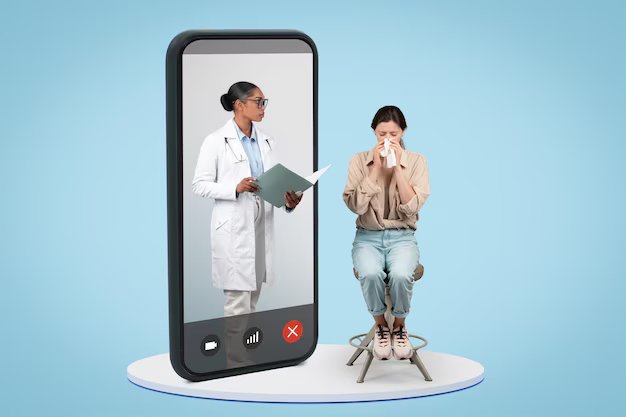You wake up with a painful sore throat at 2 AM. Your child has a fever that won’t break. You’re experiencing chest tightness, but your heart rate seems normal. These situations fall into that grey area where you need medical attention soon, but the emergency room feels like overkill.
This is precisely where telemedicine shines brightest. As a healthcare provider who’s handled thousands of urgent care cases through digital platforms, I can tell you that most “urgent” health concerns don’t require emergency room visits—they just need the proper medical guidance quickly.
Understanding the Difference: Urgent vs. Emergency Care
The key to getting appropriate care lies in understanding what actually constitutes a medical emergency versus an urgent health concern.
True Medical Emergencies (Call 911)
- Chest pain with shortness of breath
- Common stroke warning signs include facial drooping, weakness in one arm, and trouble speaking.
- Severe allergic reactions
- Major trauma or injuries
- Loss of consciousness
- Severe bleeding that won’t stop
Urgent but Non-Emergency Conditions (Perfect for Telemedicine)
- Upper respiratory infections
- UTIs and bladder infections
- Minor skin conditions and rashes
- Mild to moderate pain
- Digestive issues
- Mental health crisis support
- Medication side effects
When Telemedicine Works Best for Urgent Care
| Condition Type | Success Rate with Telemedicine | Average Resolution Time |
|---|---|---|
| Respiratory infections | 92% | 15-30 minutes |
| UTIs and bladder issues | 89% | 20-25 minutes |
| Skin conditions | 85% | 10-20 minutes |
| Mental health support | 91% | 30-45 minutes |
| Prescription refills | 98% | 5-15 minutes |
Data from the American Telemedicine Association 2023 outcomes study
How Telemedicine Handles Urgent Situations
Triage Process That Actually Works
When you connect with an urgent care telemedicine service, you’re not just getting a random doctor on call. Here’s how the process typically works:
- Initial Assessment (2-3 minutes): You answer specific questions about your symptoms through a secure platform. This isn’t a generic form—it’s designed to help medical professionals understand the urgency and nature of your situation.
- Provider Matching (1-2 minutes): The system connects you with a healthcare provider who has experience with your type of concern. If you’re dealing with a potential UTI, you might get connected to a family medicine doctor or nurse practitioner who handles these regularly.
- Clinical Evaluation (10-20 minutes): Your provider conducts a virtual examination, asking targeted questions and having you perform simple tests they can observe through video.
Real-Time Problem Solving
The beauty of urgent telemedicine isn’t just speed—it’s the ability to get immediate answers and take action right away.
- Prescription management: If you need antibiotics for a bacterial infection, your provider can send the prescription directly to your preferred pharmacy while you’re still on the call.
- Follow-up scheduling: For conditions that need monitoring, your telemedicine provider can schedule check-ins without you having to call back and wait for appointments.
- Escalation protocols: If your condition requires in-person care, urgent telemedicine services have clear pathways to get you to the right level of care quickly.
Common Urgent Situations Telemedicine Handles Best
Respiratory Infections and COVID-19 Concerns
Upper respiratory infections make up about 40% of urgent telemedicine visits. Providers can:
- Distinguish between viral and bacterial infections.
- Prescribe appropriate medications
- Provide symptom management guidance.
- Determine if COVID-19 testing is needed.
- Monitor recovery progress through follow-up calls.
Real case example: A patient contacted me at 11 PM with a sudden onset of sore throat, fever, and difficulty swallowing. Through video examination, I could see significant throat inflammation and swollen lymph nodes. I started the patient on antibiotics for strep throat and scheduled a follow-up visit in 48 hours. The patient avoided an expensive ER visit and got treatment 10 hours sooner than urgent care would have been available.
UTIs and Bladder Infections
Urinary tract infections can be highly uncomfortable and tend to worsen quickly without treatment. Telemedicine providers can:
- Assess symptoms through detailed questioning
- Order urine tests at local labs if needed
- Prescribe antibiotics immediately
- Provide pain management recommendations
- Schedule follow-up to ensure infection clears
Skin Conditions and Rashes
Visual Assessment makes telemedicine particularly effective for skin issues:
- Allergic reactions that aren’t life-threatening
- Suspicious moles or skin changes
- Eczema and dermatitis flares
- Minor wound care guidance
- Insect bites and stings
| Skin Condition | Can Diagnose via Telemedicine | Typical Treatment Time |
|---|---|---|
| Contact dermatitis | Yes (95% accuracy) | 15 minutes |
| Suspicious moles | Partial (may need in-person follow-up) | 20 minutes |
| Insect bites | Yes (90% accuracy) | 10 minutes |
| Minor cuts/wounds | Yes for care guidance | 15 minutes |
| Eczema flares | Yes (92% accuracy) | 20 minutes |
Cost and Time Savings: The Real Numbers
Emergency Room vs. Telemedicine Costs
The financial difference between emergency room visits and telemedicine for urgent care is significant:
| Care Setting | Average Cost | Average Wait Time | Typical Resolution Time |
|---|---|---|---|
| Emergency Room | $1,200-$3,000 | 2-6 hours | 4-8 hours total |
| Urgent Care Center | $300-$600 | 30-90 minutes | 1-3 hours total |
| Telemedicine Urgent Care | $75-$200 | 2-15 minutes | 15-45 minutes total |
Based on Healthcare Financial Management Association data and insurance claim analysis
Insurance Coverage for Urgent Telemedicine
Most major insurance plans now cover urgent telemedicine visits at the same rate as in-person urgent care. This includes:
- Medicare: Covers telemedicine for urgent conditions, especially since COVID-19 policy changes became permanent.
- Medicaid: Coverage varies by state, but most include urgent telemedicine services.
- Private insurance: Generally covers telemedicine and urgent care with the same copay as office visits.
- Eligible for HSA/FSA: You can use health savings or flexible spending accounts for telemedicine urgent care.
Mental Health Crises: When You Need Support Now
Mental health emergencies don’t always require emergency rooms, but they do need immediate attention. Telemedicine provides crucial support for:
Anxiety and Panic Attacks
- Immediate coping strategies
- Medication adjustments if needed
- Safety planning
- Connection to ongoing mental health resources
Depression Crisis Support
- Risk assessment
- Safety planning
- Medication evaluation
- Referral to intensive outpatient programs when needed
Substance Use Concerns
- Withdrawal risk assessment
- Harm reduction strategies
- Connection to treatment programs
- Family support guidance
Important note: If you’re having thoughts of self-harm or suicide, call 988 (Suicide & Crisis Lifeline) or go to your nearest emergency room. Telemedicine works best for mental health support that doesn’t involve immediate safety risks.
Choosing the Right Urgent Telemedicine Service
What to Look for in Quality Urgent Care Platforms
- Board-certified providers: Make sure the service uses licensed physicians, nurse practitioners, or physician assistants who are board-certified in relevant specialities.
- 24/7 availability: True urgent care doesn’t follow business hours. Look for services that provide round-the-clock access to medical providers.
- Prescription capabilities: Your telemedicine provider should be able to prescribe medications and send them directly to your pharmacy.
- Clear escalation protocols: The service should have established relationships with local emergency departments and urgent care centres for situations that require in-person care.
- Medical record integration: Your telemedicine visit should become part of your permanent medical record and be accessible to your primary care provider.
Red Flags to Avoid
Some telemedicine services prioritise volume over quality care. Avoid platforms that:
- Don’t verify provider credentials clearly
- Promise to treat any condition via telemedicine
- Don’t ask detailed questions about your symptoms
- Can’t provide clear information about when you need in-person care
- Don’t maintain proper medical records
Getting the Most from Your Urgent Telemedicine Visit
Before You Connect
Have your information ready:
- Current medications and dosages
- Known allergies
- Insurance information
- Pharmacy information
- Brief timeline of your symptoms
Prepare your space:
- Good lighting for video calls
- Quiet environment
- Reliable internet connection
- Thermometer, if you have one
Know your baseline:
- Your normal blood pressure, if you have a monitor
- Recent weight
- When you last ate (important for some conditions)
During Your Visit
- Be specific about symptoms: Instead of “I don’t feel well,” say “I have a sharp pain in my lower right abdomen that started 4 hours ago and gets worse when I move.”
- Ask about follow-up: Find out when you should expect to feel better and what signs would indicate you need additional care.
- Understand the treatment plan: Make sure you’re clear on medication instructions, activity restrictions, and warning signs to watch for.
- Get it in writing: Most platforms provide visit summaries. Save these for your records and to share with your primary care provider.
When to Escalate from Telemedicine to In-Person Care
Even the best telemedicine providers know their limitations. You should seek immediate in-person care if:
During Your Telemedicine Visit
- Your provider recommends an in-person evaluation.
- Your symptoms worsen significantly during the call.
- Physical examination findings suggest a more serious condition.
After Your Visit
- Your symptoms don’t improve as expected within the timeframe discussed.
- New symptoms develop
- You develop signs that your provider specifically told you to watch for
Technology Limitations Require In-Person Care
Some urgent conditions simply can’t be fully evaluated through video calls:
- Severe abdominal pain requiring physical examination
- Eye injuries or sudden vision changes
- Suspected fractures or serious injuries
- Severe dehydration requiring IV fluids
Urgent Care is Digital-First
Urgent telemedicine isn’t just a convenience—it’s becoming the standard of care for non-emergency urgent health needs. The data show better outcomes, lower costs, and higher patient satisfaction compared to traditional urgent care approaches.
- Patient satisfaction rates for urgent telemedicine consistently exceed 90%, compared to 75-80% for emergency department visits for non-emergency conditions.
- Clinical outcomes show that patients who use telemedicine for appropriate urgent conditions have similar or better health outcomes compared to those who use traditional urgent care.
- Healthcare system benefits include reduced emergency department overcrowding and more efficient use of healthcare resources.
The next time you’re faced with an urgent health concern that’s keeping you up at night or disrupting your day, consider telemedicine first. It might just be the fastest, most effective way to get the care you need—without the wait, cost, or inconvenience of traditional urgent care options.
Your health concerns are valid, whether they happen at 2 PM or 2 AM. Telemedicine ensures that qualified medical care is available when you need it most, bridging the gap between “this can wait” and “this is an emergency.”
For more information on telemedicine standards and regulations, visit the American Telemedicine Association and the Centres for Medicare & Medicaid Services telemedicine resources.

